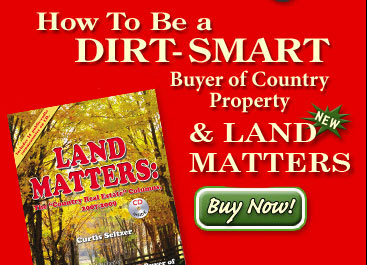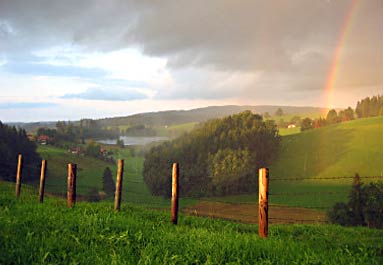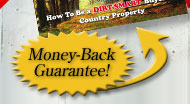This original column is provided free for one-time use with author credit at the end. It may be used for background with author credit. Copyright applies.
#79 FOR IMMEDIATE RELEASE: March 26, 2009
We walk and talk: A Bub in the woods
By Curtis Seltzer
BLUE GRASS, Va.—Three big helicopters flew in low and fast over Devil’s Backbone, the 4,000-foot-high Appalachian ridge that is the eastern rim of my end of Virginia’s Blue Grass Valley.
They landed soft about 8:30 on Saturday morning in the front pasture.
Sophie and Lucy, our two yellow Labs, barked once between them, then ducked under the porch, paws over their eyes.
Four black vans suddenly rumbled across my bridge. Forty linebackers in black shoes, black suits and shades jumped out.
Ten surrounded me as I stood next to The Cheetah, my ancient farm pickup that has found a second career as decomposing performance art. A dozen or so scoped The Cheetah for infectious diseases, unimprovised explosiveness and material defects, all of which were found a-plenty. The rest pointed automatic weapons at the five steers in the next pasture who might have been Islamic Jihadists in Black Angus clothing.
“ID,” the shadiest one demanded.
“I live here. Bub came to visit.”
He looked me up and down, from my scuffed work boots to my mended blue jeans to my gray “Oberlin Lacrosse” T-shirt now in the near-death stage of all-cotton leprosy. “You gotta be kidding.”
Bub saved me from warrantless detention. Dressed in a new denim work shirt and jeans with ironed creases, he assured the agents that I was “reasonably harmless in most circumstances.”
Bub and I climbed into The Cheetah and drove into the woods, with Lucy and Sophie in the back, barking at the convoy of shades behind us. The girls figured I had their backs. They’re nice dogs, but not bright.
We got out. “You wanna walk or work?” I asked.
“Walk and talk, maybe work later.”
“Plink?” I asked.
“Never have.”
I pulled out my rifle. Thirty linebackers buried me for a loss in my own end zone. The other 10 targeted me with stealth howitzers concealed under their suit jackets.
“Fellas,” Bub pleaded with the Secret Service. “We’re just out to enjoy the day.”
I “chiropracted” my remaining limbs back to their approximate original positions, and we started off. Sophie and Lucy blasted ahead, sniffing and poking around for dead stuff like reporters looking for vanished TARP billions.
“How’s it going?” I asked.
He laughed. “It could be worse. If we don’t get the banks acting like banks again, except better, we’ll be into temporary nationalization where we don’t want to be. Can you imagine FEMA running our 30 largest banks? Anyway, tell me what I’m looking at.”
“We’re walking on an old logging road. We cut some timber about five years ago. What do you see over there?
“An ugly pile of tree branches with a lot of thorny brambles all mixed in and around.”
“They’re tree tops -- called, slash -- from the logging. Look closer.”
He stopped. “Ah! I see four, five, six saplings, each about 10-feet tall.”
“The seedlings survive because they’re in that mess which protects them from deer. Slash also helps bunnies and that crowd.”
“Don’t diss Bambi and Thumper. My kids love ‘em.”
“Too many Bambis are bad for their habitat and themselves too. Bambis are real people, so to speak, not cartoons. That’s just the way it is.”
Bub pointed to a monster sugar maple with weightlifter limbs rising from its trunk like a hydra on hormones.
“Well, you might call that old growth,” I said. “Maybe 150 years.”
“It’s falling apart,” he said.
“Each tree species has its own life span. They’re more susceptible to breakage, insects and disease as they age, just like us. An old-growth forest around here has health problems, but we like to protect them even so. You’re looking at a mixed-age forest, heavy to maples lower down and oaks higher up.”
“So this isn’t close to wilderness, what I’m walking through?”
“No, it’s just some west-facing woods at about 3,000 feet that have been used for timber since the late 1700s. Genuine wilderness is almost impossible to find in the East.
I bring The Cheetah up here for wind sprints and to listen to my latest list of grievances and outrage.”
“What’s that stump?” he asked, pointing to a huge grey carcass with red rot inside.
“That’s what’s left of the American chestnut. See how high the stump is, about four feet. They took it down by hand with two on a crosscut saw. Probably in the late 20s. The chestnut blight fungus killed something like four billion trees. You can see it was about five feet in diameter, enormous by today’s standard for eastern hardwoods. A century ago, this hillside was thick with chestnut. So throw a few bucks into bringing it back if you want to do something for your great-grand kids.”
“Why are those trees dead?”
“They’re hemlock. A little bugger called the woolly adelgid killed them a couple of years ago. Some survived, but with a lot less green.”
“Is this a healthy forest I’m looking at?”
“It has issues. The dirt’s in good shape, and there’s little soil erosion. But the trees are vulnerable to non-native diseases and insects. The fire hazard’s pretty low, because there’s not a lot of dead wood. But remember, this would be considered a managed forest even counting that I’m the manager. The woods that are most vulnerable are the public lands, yours, in a manner of speaking, particularly aging wilderness areas.”
We stopped in front of a cut bank. “Wanna shoot?” I asked.
“You wanna get tackled again?”
“You mean you’re not going to take home a genuinely wild, totally organic, free-range, sustainably-raised-in-Nature woodchuck for Michelle’s supper?”
“She’s learned to live with many disappointments in our marriage,” he laughed. “Maybe the kids and I will plant a tree or two at the White House.”
“While you’re at it, plant a couple in a National Forest where they will be part of the country’s sustainable energy future.”
“You know what? I might like to be remembered as the first green President more than the first black President.”
“Well, you could do both.”
We walked back to the road where the shades were blaming each other for allowing POTUS to ride around with the likes of me in the likes of The Cheetah.
“I like this woods stuff,” he said.
“Next time you can drive.”
“Deal,” Bub said, as 40 shades shook their heads no.
Curtis Seltzer is a land consultant who works with buyers and helps sellers with marketing plans. He is author of How To Be a DIRT-SMART Buyer of Country Property at www.curtis-seltzer.com where his weekly columns are posted. He also writes for www.landthink.com.
BONUS: “Bub was here”
The Obamas started a garden at the White House last week. Country Real Estate on November 6, 2008 scooped everyone on this secret, thus proving that the author is not as bad a reporter as you’ve been led to believe. Here’s the proof.
“Know anything about farming?” I asked.
[Bub replied:] “‘There was a farmer who had a dog, and Bingo was his name-O.’ My kids taught it to me.”
“It’s a start.”
“Maybe we’ll put a little garden in at the White House. Do the work ourselves.”
“Good metaphor…also good for you. Don’t make a big deal about it. Don’t staff out the weeding.”
Contact: Curtis Seltzer, Ph.D.
Land Consultant
1467 Wimer Mountain Road
Blue Grass, VA 24413-2307
540-474-3297
curtisseltzer@htcnet.org
www.curtis-seltzer.com
This original column is provided free for one-time use with author credit at the end. It may be used for background with author credit. Copyright applies.
|









